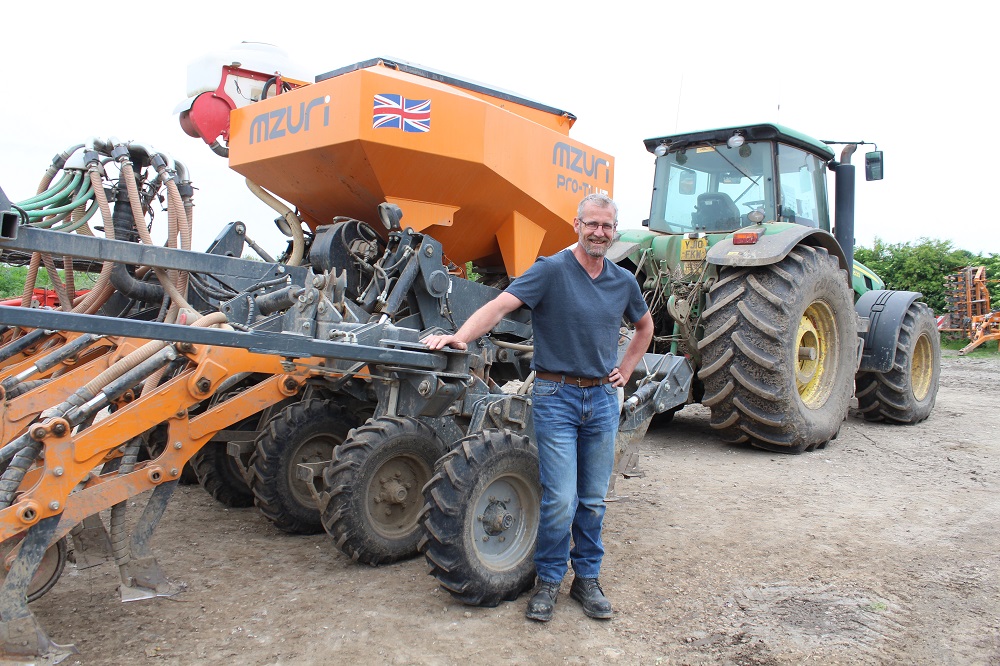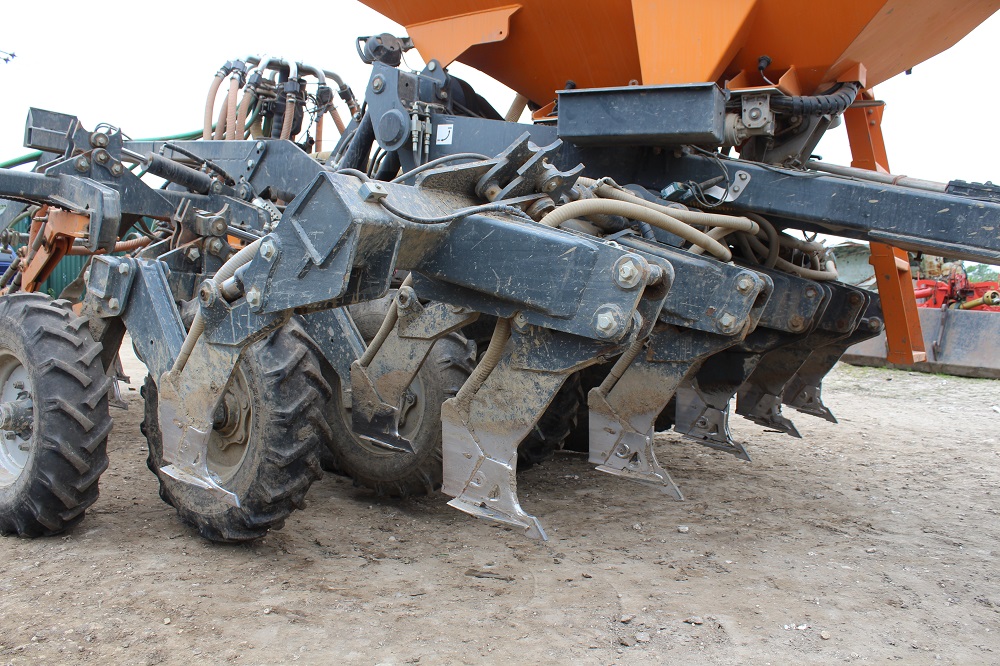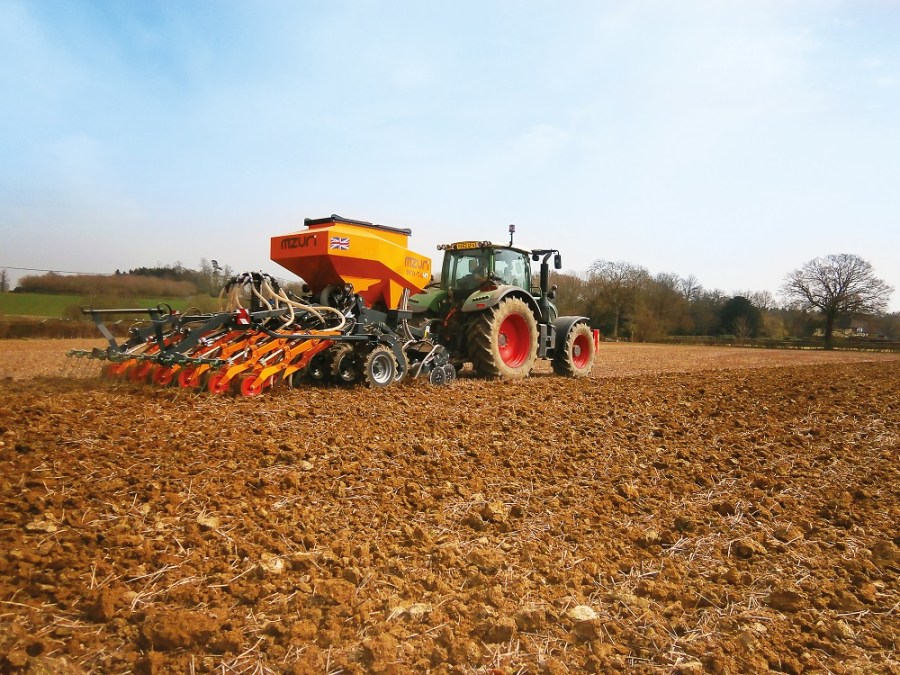Ditching a conventional tillage system for a one-pass strip-till drill is helping one Yorks farmer get his tired soils into shape. CPM finds out how it’s bedding in.
My costs have reduced, my yields are as good as if not better than before and my soils structure is in much better condition.
By Ted Fleetwood
Knocking heavy, unyielding clay soils into an acceptable-looking seedbed is rarely an easy or cheap task.
But when you’re based in a wetter-than-ideal location and your land drains pass water slower than a pensioner with prostate problems, the job is even less entertaining.
David Blacker farms more than 800ha of combinable crops in the Vale of York and has been battling precisely this problem for most of his farming career. A large proportion of his ground is heavy clay loam over clay and hasn’t had any significant drainage work done since the 1960s and 1970s.
Up until 2014, he was trying to get his crops established using a mixture of ploughing and minimum tillage, but the mounting costs of getting the soils into decent condition meant something had to change.
“For years we’d used a Moore Unidrill, which had its strengths, but we had to do so much cultivation work in front of it that I’d probably call it maxi-till rather than min till,” he says.
Ploughed ground
Ground that he did plough was generally power harrowed at least once, drilled and then rolled. The rest was ripped up by a Sumo trio before getting a pass or two with the power harrows ahead of the drill.
Often this approach meant he had to employ a five-gang cultivation team and bills for establishing a crop were at least £150/ha, sometimes rising to £200/ha or more.
Frustrated with all this extra work, expense and the fact the Moore Unidrill would often block up on cloddy ground, he traded it and drafted in the services of a Horsch Pronto disc drill.
The idea was that this would enable him to drill directly into furrows or ground prepared by the Sumo, but in reality most still needed a run through with the harrows to break up the bigger clods.

David Blacker was spending more than £150/ha on establishing crops and was frustrated by the extra work this brought on his heavy clays.
This system continued for a couple of years, but the situation came to a head in 2012. That year was “seriously wet” and it was the final kick David Blacker needed to make a more drastic change.
He started off ploughing with seven furrows behind his 350hp John Deere 8530, but it was so soggy the tractor just spun its wheels and he was forced to drop down to six furrows.
“When we couldn’t pull that either, we resorted to closing up the front furrow so it was effectively reduced to a five-furrow, and in some cases we were still getting stuck,” he says.
“We were just mauling the crops in and I don’t know what you’d call it, but it certainly wasn’t drilling.”
In the end, he was forced to abandon ship and re-drill in the spring. After that debacle he started looking into alternative methods of crop establishment that didn’t involve heavy cultivation. “I didn’t want to keep farming like that, particularly as wetter seasons seemed to be getting more frequent,” he says.
One of the options was to go down the no-till route, but because his land is heavy and poorly drained he though there would be too much of a yield penalty in the first few years of the conversion.
So with that out of the window, he settled on the idea of going for a strip-till machine. This meant he would still get a decent tilth, but only work the ground where the seed was to be planted.
His mind was made up further when he noticed that a neighbour running a Claydon Hybrid drill had less standing water than anyone else in the area.
After doing plenty of research, David Blacker whittled his choices down to either the Claydon Hybrid or a Mzuri Pro-Til, which is designed and built by Worcs farmer Martin Lole.
Both had their benefits, but in the end he plumped for the Mzuri as it worked the ground a little more aggressively than the Claydon. “I just didn’t think the Claydon would do enough cultivation work to deal with our anaerobic clays and the Mzuri ticked the boxes more than anything else on the market,” he says.
So a deal was done on a 4m folding Mzuri Pro-Til 4T, which arrived on the farm in autumn 2013, ready to start dealing with the mess left after the challenges of the previous year.
At the front, this drill has a straight disc that cuts a neat slot for the main cultivation leg to run in. The idea is that this chops through any trash, preventing it hooking round the leg and it also stops soil being moved outside the cultivated band.
The cultivation leg itself is heavier-duty than the one used by Claydon and has a winged foot that loosens the ground and pulls up fresh earth for the seed to be planted in. These have hydraulic

The cultivation leg itself is heavy duty and has a winged foot that loosens the ground and pulls up fresh earth for the seed to be planted in.
break-back protection so that you don’t have to worry about replacing shear bolts in stony conditions.
This freshly moved soil is then pressed with a pneumatic rubber tyre, before the coulter places the seed.
Cleverly, Mzuri has mounted the coulters on a horizontal pivot so that the seed gets placed in the centre of the tilled strip, even when turning sharp corners on the headlands.
When drilling cereals, the seed is placed in two bands, but for oilseed rape and beans it gets drilled in a single band with 33cm spacing between.
The drill has now planted three seasons’ worth of crops and, according to David Blacker, establishment results and yields have been pretty pleasing.
Seedbeds prepared by the front cultivator tine have generally been good and it doesn’t bring up too many clods. In a dry year, it also helps conserve moisture so you don’t end up with the hard, dry, lumpy seedbeds you sometimes end up with in the old plough-based system, he points out.
In the wet, it also makes a lot less mess than the min-till regime. “Autumn 2015 was almost as wet as the horror of 2012 and we have nowhere near the number of problems we had then,” says David Blacker.
“The drill doesn’t go well when it’s really wet on the top, but then you could argue you probably shouldn’t be drilling. If I can’t pull the Mzuri, I wouldn’t be able to plough or make a pass with a Sumo either. However, I can get back on to drill stubble fields after rain much quicker than i could if they were cultivated.”
The drill’s ability to deal with trashy conditions also gets the nod. “It really is impressive and like no other drill out there. No amount of chopped straw or cover crop residue has even come close to stopping it working or affecting its performance.
Seed placement
In terms of seed placement, the Mzuri’s coulter does a good job as any drill he’s seen. “but we have soil types that vary from one end of the field to the other, which can be a challenge particularly with small seed – if you’re not careful you can bury them too deep. The Mzuri copes well with the variability where other drills we’ve had have struggled.”
The Mzuri Pro-Til offers the option of a split hopper and can be fitted with a separate applicator for small seed and slug pellets. “One of the things that drew me to the Mzuri is that it can brand-apply fertiliser or put on slug pellets in the same pass – it’s very versatile.
For cover crops, he now puts the small seeds on with the slug pellet applicator, which dribbles them behind the main coulters, and covers them with the following harrow.
In the three years since the drill arrived on the farm, David Blacker says yields have remained fairly static, apart from the 2015 harvest season, which was a farm record.
But the main benefit of the drill has been the massive fuel saving. Compared with the £150-£200/ha establishment cost of the old system, the Mzuri’s £62/ha cost seems pretty reasonable.
“Overall, my fuel consumption for crop establishment dropped by 30,000 litres, which shaved £12,000 off my fuel bill,” says David Blacker.
It’s also put an end to having to hunt around for an army of casual labour at cultivation time, when most students have gone back to college. “Overall, the Mzuri is a great bit of kit – it’s well made, does a good job and the backup is fantastic,” he says.
“My costs have reduced, my yields are as good as if not better than before and my soils structure is in much better condition – I wouldn’t go back to the way I was cultivating before.” Although the Mzuri has produced some good results, there have been a few teething problems.
Firstly, the drill’s original weld-on subsoiler points were wearing out after about 40ha. With so much ground to cover and the drill sometimes working on 24-hour shifts, this was starting to get tedious.
However, Mzuri quickly came up with a set of considerably tougher knock-on tungsten points that are easier to replace and will easily last a season.
The chassis also had to be strengthened in places and Mzuri had to add a following harrow after the original coulter boards failed to cover the seed.
“When you buy something relatively new you expect there to be a few niggles,” says David Blacker.
“But to be fair to Mzuri, they’ve all been sorted out as quickly as possible and whenever the engineers have come up with a modification they’ve come out and fitted it for free. I’ve never experienced before such a high standard of aftersales care and attention to detail from a manufacturer.”
Tech specs: David Blacker’s Mzuri Pro-Til 4T
- Width: 4m
- Age: 2012
- Hopper: 2t seed and fertiliser
- Coulters: 11 tines
- Metering system: RDS Artemis
- Price paid: £65,000
Switching rotation
With the arrival of the Mzuri drill, David Blacker decided he’d also make some dramatic changes to his rotation and cropping approach.
For years he’d been a keen milling wheat grower and had been religiously been putting second wheats into the rotation, too.
However, after taking a closer look at his figures he decided the cost of growing these crops was just too high. “I did the sums on all four blocks of land that I farm and my second wheat crops were losing money on all of them.”
The small milling premium at the time also meant it was too high risk for him to ploughing the extra inputs to get the quality.
His answer was to grow a wheat, OSR, wheat and spring beans rotation with a cover crop thrown in between the wheat and beans. He also decided to grow clean wheat varieties and only go for feed spec. The idea was that he’d cut his input costs, reduce risk and start “respecting his soils” a bit more, too.
“I’d rather not have OSR in there either, but there really is no other viable option – if there was I’d kick it out in a heartbeat,” he says.
Soil improvement
Improving soil structure is one of the key aims of David Blacker’s farm management strategy and to do so, he’s put a number of changes into his system.
Compost
For the past three years he’s been trialling the effects of applying 35t/ha of PAS 100 compost on to the same block of land, aiming to build up its organic matter content.
Already he says he’s seen improvements in the structure and friability of the ground and his annual soil tests show that organic matter levels are climbing as well as the P and K indices.
Cover crops
Experimenting with a number of different seed mixes, cover crops are another tool he’s using to improve soil structure and organic matter. Some of these are standard, off-the-shelf products, but he’s also had a go and putting his own blends together on the farm.
As yet these haven’t shown any significant yield, benefits, but for him the main aim is to put more organic material back into the soil, which they seem to be doing well, with some now measuring 8% organic matter content.
Drainage
To help deal worth the problem of waterlogging, David Blacker is also setting aside £10,000 a year for drainage work. Unfortunately, that doesn’t get you very far when you get a specialist drainage contractor in to do the work, so he says he’s thinking of investing in a trencher and ballast tender to go behind the John Deere 8530.
David Blacker’s identified several major challenges his system faces, so is carrying out some on-farm trials to address them.
Slug troubles
Slugs are a perennial problem on the farm, but it seems like the pressure has got worse since the switch to strip till, particularly in a wet year, he says.
“The first two seasons with the drill were fine and I didn’t have a problem with slugs. But last winter was much wetter and although crops established well enough, slug populations were high and I couldn’t control the grazing.”
One reason for this is that he’s no longer killing the slugs through cultivation, meaning the job is left entirely to the slug pellets. In a drier year these work fine, but they’re far less effective when it’s wet.
In a bid to get on top of populations he’s planning to do some trails with a Mzuri Rezult stubble rake that incorporates discs at the front to chop residue down.
Finding the P and K
Over the past few years he’s been using variable rate P and K applications to try and even up his indices across each field and the farm in general.
His nutrient maps show that the process has been working, but he hasn’t seen a significant spike in yields because of it. “We’ve managed to even up field nutrient variability very quickly, but the fact that we weren’t seeing a significant response made me wonder where the nutrients were hiding in the soil profile.”
The problem with traditional soil tests is that they take an average reading throughout the top 6 inches of soil. But this doesn’t tell you if the nutrients are in the best spot for the plant’s roots to get hold of them.
In a bid to find out where the nutrients were lurking, David Blacker dug a soil pit and took multiple samples throughout the profile.
The results were surprising. Almost all P and K was concentrated in the top 75mm of the soil, with very little in the mid-section and then another spike at around 200mm depth – possibly due to the previous ploughing regime that turned the nutrients into the bottom of the furrow.
“If you look a plant’s root structure, most of it’s below 75mm deep where there can be very little P and K,” says David Blacker. “Now that I can apply fertiliser with the front leg of the Mzuri, I can get it deeper into the soil profile”
Other trials
Other on-farm trails are looking at the effects of using SDHIs instead of conventional fungicides, applying Nutrifite liquid phosphate, planting clover under OSR and applying a Nufol nitrogen application at flowering.
“Out of every trial I’ve done, the Nufol seems to be the only one that’s shown a tangible yield benefit and we’re consistently getting an extra 0.5-0.75t/ha when we’ve used it,” says David Blacker.
This year he’s also doing a trial in conjunction with ADAS looking at the benefits of micro and macronutrient products Delta, 1-4-All and Tip Top on wheat yields. “They’ll have to do a lot to prove themselves as we have to put on eight applications in total and they cost a fortune,” he says.
Farm facts
- Farmed area: 800ha
- Staff: One full-time and one 10 months of the year
- Soil type: Mainly heavy clay loam over clay with some sandy loams
- Cropping: Wheat (average yield 9t/ha), oilseed rape (4t/ha), spring beans (6t/ha)
- Mainline tractors: John Deere 8530, 7530, 6920 and 6910
- Sprayer: Sands SLC 4000 with 24m booms
- Combines: Claas Lexion 760 with 9.1m header and Lexion 560 with 7.6m header
- Drills: Mzuri Pro-Til4T and KRM 4m power-harrow combination
Cultivation: 7-furrow semi-mounted plough, 4m folding power harrow




